|
January 31st, 2014
2014 is already approaching February! I sincerely hope the beginning of everyone’s year has been smooth and that you all are in good health and that the year ahead will be everything you want it to be.
2014年ももうじき2月を迎えようとしておりますが、FOM会員の皆様にとり、健康でスムーズな年初めであった事、そして残り11ヶ月余が充実した時になる事・・・を念じて居ります。
At 3:00 p.m. on October 6th, 2013 three Japanese – along with several Americans – were at Fort Astoria (Ft. George) National Historic Site. The three were gazing at the stone monument entitled “The Birth Place of Ranald MacDonald”. The scene was not unusual, but it was quite historic! 時は2013年10月6日午後3時、数人のアメリカ人に混ざって3人の日本人がFort Astoria 史跡公園を訪れていた。3人はその一遇に建つ「マクドナルド生誕の地」と刻まれた石碑に見入っていた。それ自体珍しい光景ではなかったが、それは大変歴史的な出来事であった。
Ranald MacDonald was born at Fort Astoria (Fort George) on February 3, 1824 the son of Archibald McDonald and Princess Sunday, a daughter of Chinook Indian Chief. In 1848, Ranald – a grown to be a strong 24 year-old sailor – succeeded in landing on an a small island in the Sea of Japan off northern- most Hokkaido. At that time it was generally regarded as an unattainable venture to enter Japan; however, with the careful planning of a “faked shipwreck”, Ranald was saved by Ainu people and the result was a successful landing onto Japanese soil. Soon after that, Ranald was arrested as an unlawful intruder and was transported to Nagasaki under “house arrest” at Daihian, where the translators of Dejima were taught English by Ranald. That is why Ranald is regarded as the first Native English Teacher in Japan. ラナルド・マクドナルドは、スコットランド人アーチボルド・マクドナルドを父に、チヌーク族族長の娘、プリンセス・サンデーを母とし、ここFort Astoria (Fort George) で1824年2月3日に産声をあげた。そして1848年、24歳のたくましい船員に成長したラナルドは北海道北端の日本海に浮かぶ利尻島への単独上陸に成功した。当時鎖国令を敷いていた日本への入国は無謀・・・と思われていたが、ラナルドは緻密な計画に従い遭難を偽装、かけつけたアイヌに救助され、結果的に目的を果たしたのだった。しかし、その後不法入国者・・・として幕府に捕えられ長崎へ護送された後、座敷牢”大悲庵”に幽閉されたが、そこで出島の通詞達に英語を教えた事が今日マクドナルドを「日本で最初のネイティブ英語教師」と位置付けている所以である。
The three Japanese at Fort Astoria were two students, Yuuki Komatsu and Tatsuya Koujiya of Rishiri High School and their principle, Mr. Hiroyuki Tsukamoto. The three had arrived at Portland International Airport a day earlier, October 5, 2013. So it was that 165 years since Ranald landed on Rishiri Island, three people from Rishiri came to visit Astoria, the birth place of Ranald MacDonald. There are only two towns on Rishiri Island: Rishiri-cho and Rishirifuji-cho. In December 2012 the citizens, the businesses and other groups in both towns got together and established “A Support Group for MacDonald Scholarship Funds” in order to support the only high school on the Island, Rishiri Senior High School. The objective is to send a few students annually to the US, in particular, to Oregon and Washington states, where Ranald had close ties – and thus encourage students to study English and assist students to acquire an “International mind and etiquette”. The next few pages are copies of newspaper articles, photos and the comments by Yuuki-kun and Tatsuya-kun from Rishiri Senior High School:
Fort Astoria に居た3人の日本人は北海道利尻高校から前日(10月5日)ポートランド国際空港に到着した留学生の小松祐希君及び糀屋達也君と付添いの塚本宏之校長先生であった。オレゴニアン、ラナルド・マクドナルドが利尻島に上陸して以来、実に165年間を経た2013年に利尻島からの3人はラナルドの生誕地、アストリアへやって来たのであった。利尻島内には利尻町及び利尻富士町という2つの町が在るが両町の町民や企業、団体が島の将来の為協力し同島内唯一の利尻高校を支援し元気付けようと2012年12月に「マクドナルド奨学基金支援の会」を立ち上げた。その趣旨は毎年何人かの利尻高校生を米国(特にマクドナルドゆかりの地、オレゴンとワシントン州)へ短期留学させ、生徒達の英語学習欲を促し、同時に国際感覚養成に役立てるというものだった。 以下、小松君及び糀屋君のオレゴン及びワシントン州への第1回留学に関する新聞記事や写真、両君の感想等を掲載させて頂く:
ご報告: 2013年5月11日のFOM年次総会席上ご承認頂きました「FOMよりマクドナルド奨学基金 支援の会への寄付10口分として¥50,000」を実行致しました。
Report: We have donated 50,000 yen to The MacDonald Scholarship Fund in Rishiri Island from FOM General Funds per approval during the annual luncheon meeting in Astoria on May 11, 2013.
FOM Chairman 谷田部 勝/Masaru “Mas” Yatabe
* * * * *
朝日新聞 — Asahi Shimbun
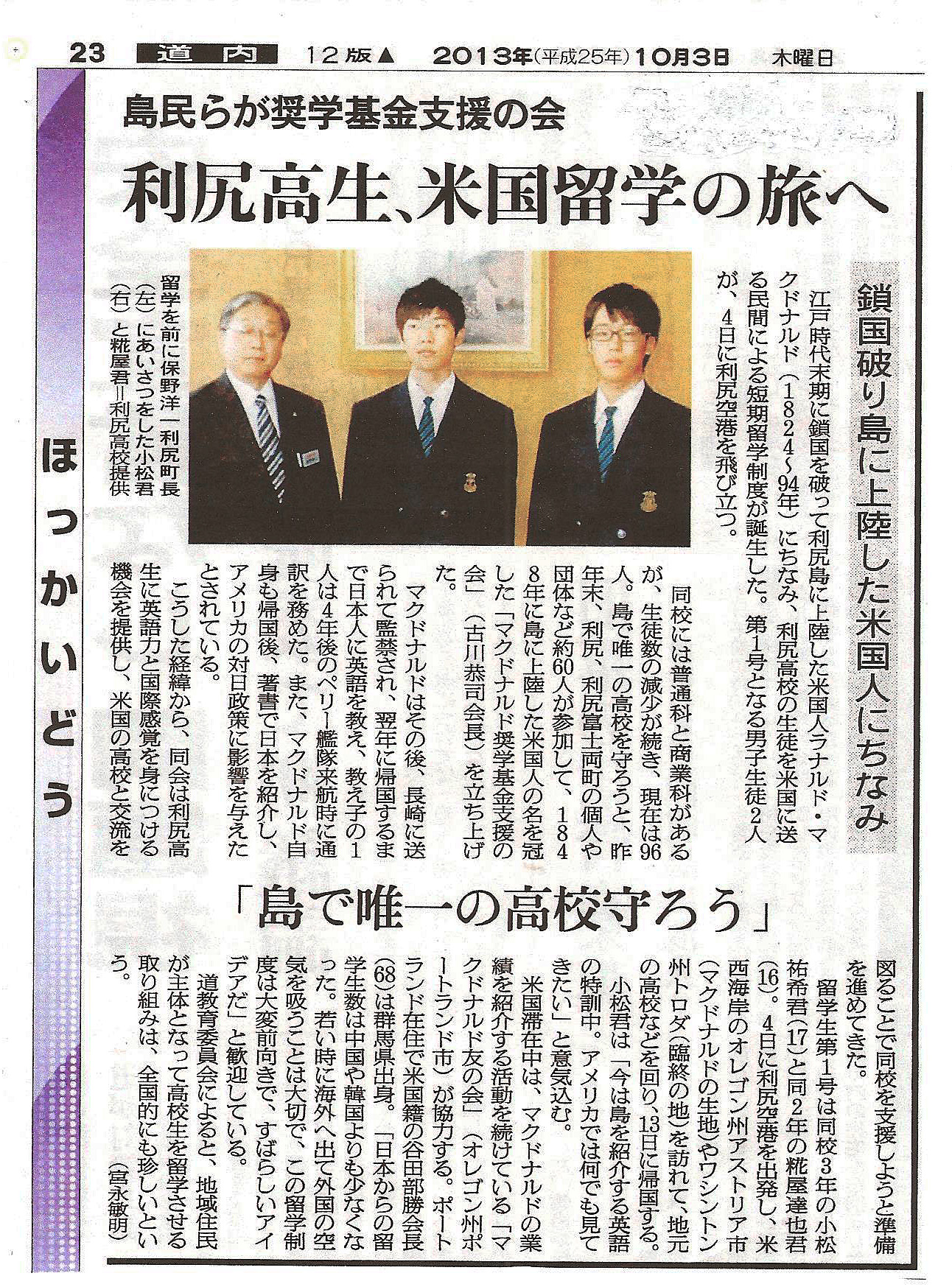
Our Overall Impressions
3年 小松 祐希/Yuuki Komatsu, Senior
僕は今回、アメリカ研修留学に行って本当によかったと思っています。 それは、たくさんの人に出会い、たくさんの事を学び、広く視野を広げることが出来たからです。ですが、1つ後悔をした事が在ります。それは「もっと英語の勉強をしておけばよかった」ということです。 アメリカでの生活の中で1番困ったのが「英会話」でした。あまり英語が話せなくても楽しく8日間をすごすことができましたが、ちゃんと英語が話せればもっともっと楽しく充実した8日間になったのかな。と思うととても悔しく思いました。来年度からもこの事業が続いて行くという事なので、次回の留学生には僕のように後悔をせず心からアメリカでの生活を楽しんできてもらいたいです。なので、学校での英語勉強の徹底をした方がいいと思いました。このような体験ができたのもマクドナルド奨学金支援の会の方々や利尻町、利尻富士町両町のご支援ご協力があったからです。今回学んだことを残りの高校生活、そして卒業後の学生生活に活かしていこうと思います。この度は、本当にありがとうございました。
I am truly glad that I went to America to study this time. It enabled me to meet many people, learn many things and gave me a broader perspective. However, I do have one regret: I should have studied English harder. The most troublesome thing for me was English conversation. It made me feel sorry when I realized the 8 days would have been a lot more enjoyable if I had had better command of English – even though those 8 days were fun days. I understand that this program will continue on to next year and beyond; I hope future participants will enjoy the experience fully and without regret. Therefore, it will be a good idea to make sure the student(s) study English seriously and with diligence. I was able to have this valuable experience because of the assistance and cooperation of the people of ‘MacDonald Scholarship Fund Support Group’ and the Towns of Rishiri and Rishirifuji. I intend to apply and utilize what I learned to the rest of my High School life and my life after graduation. Thank you very much.
2年 糀屋 達也/Tatsuya Koujiya, Junior
今回の留学研修は自分にとってとてもためになり研修となりました。初めてアメリカに行き、たくさんの驚きがありました。特に僕が印象に残っているのは、むこうの学校に行き、生徒と交流をした事です。言葉がなかなか通じない中、身振り手振りでコミュニケーションをとり、一緒に授業を受けたことが一番楽しかったです。又、ホームステイなどでは、一人で外国人の中に入っていって何日間か過ごしました。そのなかで困ったときにも自分でしっかり対処できたことにより、少し自信を持つことができました。今回の研修で日本とアメリカの文化の違いを体験したことで、日本にいただけでは感じることのできなかった世界観や視野をこれからの進路にいかしていきたいと思います。最後になりましたが、利尻町、利尻富士町のみなさん、そしてマクドナルド基金のみなさんには、ご支援いただき、このような機会を作っていただいたことに深く感謝します。来年ももし行く機会があれば、また行ってみたいです。
Studying abroad was a very good experience for me and visiting America for the first time gave me many surprises. I will always remember going to school in America and exchanging ideas with the students I met. The most enjoyable thing was to go to class together (with American students) even though we had language difficulty and had to depend on our hands and body gestures a lot for communication. I was alone among foreigners for a few days during the home stay, and I gained confidence in myself when I was able to work out a problem by myself. In the future I hope I can apply the worldwide perspective which I gained through experiencing the cultural differences between Japan and America during the study tour, experiences I could not have enjoyed had I stayed in Japan. Last, but not least, I would like to express my deep appreciation to the people of the Towns of Rishiri and Rishirifuji and the members of ‘MacDonald Scholarship’ funds. If I could go again next year, I would love to.
Posted in Gates Ajar, Home | Comments Off on Happy 2014 A Little Bit Late
July 6th, 2013
A new book entitled “Ranald・MacDonald” has been written by FOM International member and English teacher, Ms. Yuko Imanishi, who lives in the suburb of Nagoya, Japan. The book is being published by “Bungeisha Co., Inc.” with a release date of June 15, 2013 [the price is ¥1,400 plus tax].
The book is written in Japanese and 218 pages long and is described as the story of an American who entered Japan when the nation was closed to the outsiders and ended up being the first “native English-speaking” English teacher in Japan [5 years prior to Commodore Perry’s first visit to Japan in 1853.]
Ms. Imanishi came across the story of Ranald MacDonald in 2009 during a visit to her friend in Astoria, Oregon while on vacation in May of that year. Imanishi first saw the Ft. Astoria birthplace monument of MacDonald while taking a walk in this small town off the Pacific Ocean. It was quite an awakening for her when she read the inscribed words “the first English teacher in Japan”. An English teacher herself, Ms. Imanishi became intrigued; she studied and read many books about MacDonald, leading to a fascination with this remarkable American. MacDonald’s adventurous, fearless and forward-looking attitude – which was based on his belief that all people are basically the same – stimulated Imanishi’s imagination and her ‘need’ to write about him. MacDonald’s positive attitude and belief in people and his subsequent fearless endeavor in Japan was quite unusual – even unthinkable – under the iron fist of the Shogunate at that time. How incredible was MacDonald’s “story” and yet how little-known it remained! This realization fueled Imanishi’s desire to write a book that would enlighten more people in Japan about the extraordinary individual named Ranald MacDonald.
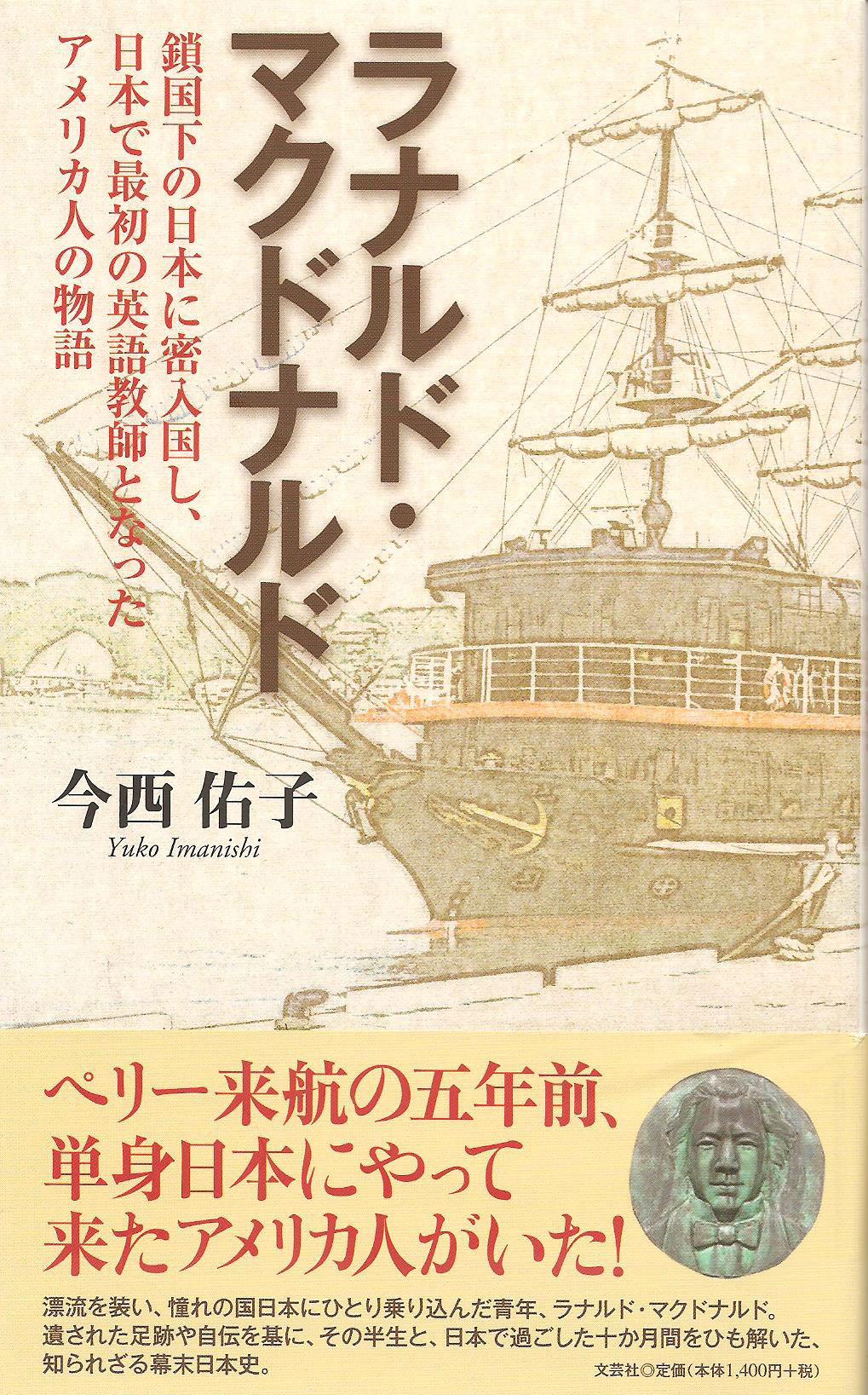 名古屋市郊外在住の英語教師でマクドナルド友の会国際会員でもある今西佑子女史は、この度 ラナルド・マクドナルドと題する本を書き上げ、来る6月15日に株式会社文芸社より初版第一刷発行の運びとなった。【価格(本体)1,400円+税】 名古屋市郊外在住の英語教師でマクドナルド友の会国際会員でもある今西佑子女史は、この度 ラナルド・マクドナルドと題する本を書き上げ、来る6月15日に株式会社文芸社より初版第一刷発行の運びとなった。【価格(本体)1,400円+税】
日本語で書かれた218ページに及ぶこの本は、“鎖国下の日本に密入国し、日本で最初の(ネイティブ)英語教師となったアメリカ人の物語”と、解説されている。 更に、帯表紙には、「ペリー来航の五年前、単身日本にやって来たアメリカ人がいた!」とある。
今西女史は2009年5月の連休に友人を訪ね初めてオレゴン州アストリアを訪れた際、ラナルド・マクドナルドの物語に出会った。 太平洋に面した田舎町アストリアを散策中、史跡フォート・アストリアで“マクドナルド生誕の地”と書かれた記念碑に出くわし、更に「日本で最初の英語教師」と日本語で刻まれて居る文字を読み驚きを覚えた。 彼女自身英語教師でもあった事から興味をそそがれ、マクドナルドに関する本を読み、研究するに従い、この偉大なるアメリカ人の虜になった。 マクドナルドの冒険心と恐れを知らない、基本的に人間は皆同じ・・・との信念に基ずく前向きな態度に心を打たれた今西女史は想像力を掻き立てられ、彼に関して本を書く必要性に迫られた。マクドナルドの前向きな姿勢と人間への信条、恐れを知らない日本での行動は異常・・・と言うか、当時の鉄拳将軍の時代には到底考えられない事であった。 しかし、このマクドナルドの信じ難い“物語”はごく限られた人にしか知られて居ないのも現実である!この事に業を煮やした今西女史は、より多くの日本人にラナルド・マクドナルドなる偉大なる人物をもっと知り理解してもらいたいとの啓発心から、本書執筆に踏み切ったのであった。
Posted in FOM Japan, Gates Ajar, Home | Comments Off on New Book From Japan
July 5th, 2013
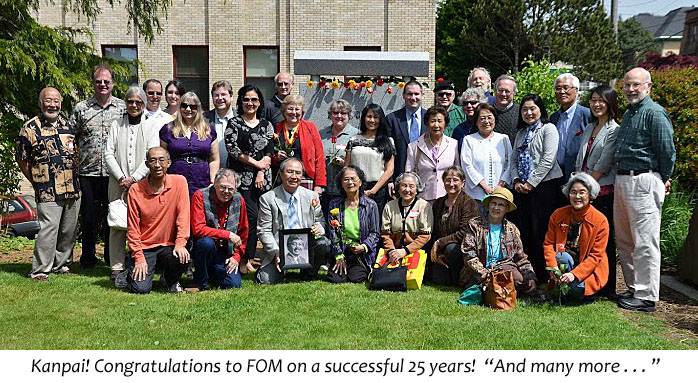
In the course of explaining exactly what and who the Friends of MacDonald are to our guests and new members, the idea and concept – if not the actual words themselves – of “Gates Ajar” pops up. This expression and these words are more than just the name of our committee’s newsletter.
When asked, we usually begin by explaining that Ranald MacDonald – though not the “first” person to do so – was the first native-English speaking person to “teach” English in Japan. Following this explanation, it has often been asked just how the 14 samurai who were Ranald’s pupils could have picked up their English proficiency so quickly – in a mere 7-months time. No doubt each of these men were ‘special’ in their own way, obviously being of high rank in Japan and quite capable, otherwise they would not have been among those chosen for the special assignment of learning English from this very peculiar and unusual foreigner. The truth is, most, if not all, of these men were already ‘employed’ as translators and cold have been considered linguistics experts; each had been studying English, perhaps for years, from the Dutch translators at Dejima. Their Dutch teacher/translators, however, spoke far from ‘perfect’ English. Using Moriyama Einosuke (perhaps the best known of Ranald’s pupils) as our example, we know that when he first met with Ranald he could already read and write English with a certain amount of fluency, and history tells us that Moriyama could also “speak” English, though with such such a heavy Dutch accent so as to be frustratingly unintelligible to native English speakers. But Moriyama and the others could read and write in English; they understood basic English vocabulary and syntax – all that was needed was some rather intense work on pronunciation, and Ranald was more than up to the task.
But back to the expression “Gates Ajar”. What could this rather ambiguous catchphrase mean in the context of an historical committee?
When Ranald approached Japan in July of 1848 her borders were sealed, her windows, doors and gates closed and virtually locked tight against the influences of the outside world. But by the time he left 10 months later there was a small breach in Japan’s armor, and the gates had been left open just a bit … ajar.
The third issue of the FOM newsletter, dated Fall 1989, introduced its distinctive title of “Gates Ajar”. There really is no mystery: the phrase comes from page 98 of MacDonald’s own autobiography where he wrote: “… I came thus to play my humble part in the drama of ‘Gates Ajar’, of west and east, in the world of the Pacific.”
Posted in Gates Ajar, Home | Comments Off on Why ‘Gates Ajar’?
May 15th, 2013
Friends of MacDonald tend the flame of a great 19th century adventurer
Posted: Tuesday, May 14, 2013 9:11 a, Daily Astorian
In the pantheon of 19th century adventurers, Ranald MacDonald’s story is one of the more astounding. Born at Fort Astoria in 1824, MacDonald was the child of a Scotsman and a Chinook Indian princess, daughter of Chief Comcomly. He went to sea on a whaling vessel, with the intention to be shipwrecked in Japan, which had excluded foreigners for some 200 years. MacDonald’s plan worked, and he brought the English language to Japan.
Writing in Eminent Astorians, Frederik L. Schodt says MacDonald: “ … is a classic example of an individual who, overcoming great odds, did something heroic then fell through the cracks of history.”
Over lunch last Saturday at the Bridgewater Bistro, the Friends of MacDonald held its 25th annual meeting. The Friends group had its genesis following the 1988 placement of a memorial stone at Fort Astoria park. On that marker, MacDonald’s story is told in English and Japanese. Local leadership from then-Astoria librarian Bruce Berney and Japanese money were the winning combination.
The Japanese make a bigger deal of MacDonald than we Americans. A woman from Kyoto traveled to the Friends of MacDonald lunch, as did the Japanese Consul from Portland.
It is said that through biography we give life to the dead. Reminding Astorians that a story of global accomplishment began here is important. The Friends’ gathering reminds us that the Columbia-Pacific region has long been a cultural crossroads.
Cities are living things. They are in a constant cycle of deterioration, death and renewal. And they have memories.
Posted in Gates Ajar, Home | Comments Off on Editorial: Astoria has a long memory
February 10th, 2013
The “Daily Souya” newspaper, dated Dec. 11, 2012, reports that a scholarship fund named “MacDonald’s Encouragement Study Fund” has been established on Rishiri Island. A committee to support and manage the Fund has also been formed with Mr. Kyoji Furukawa as its first President. Since the beginning of 2012 the leaders of Rishiri Island held a series of meetings intended to get the ground work done for devising a scholarship fund which would benefit the students of the only public high school on the island and in particular to encourage them to study English. One or two top students will be chosen from the English-language class and will be sent to America – to Oregon and/or Washington – to experience American life and to further encourage their English language skills. The program hopes to nurture the type of “internationally-minded person” who will become a human asset to Rishiri Island and will help to sustain the prosperous and happy life-style of Rishiri Island. Committee members hope that this program will encourage more students to attend Rishiri Public High School [whose student body is in decline]. We at Friends of MacDonald happily and enthusiastically go “on record” in fully supporting the “MacDonald’s Encouragement Study Fund” and it’s exchange program.
For those of you who are interested in assisting this fledgling program by either donating funds or hosting a student from Rishiri – or both – please contact Friends of MacDonald at amm@friendsofmacdonald.com .
Posted in FOM Japan, Gates Ajar, Home | Comments Off on MacDonald Scholarship Established on Rishiri
January 9th, 2013
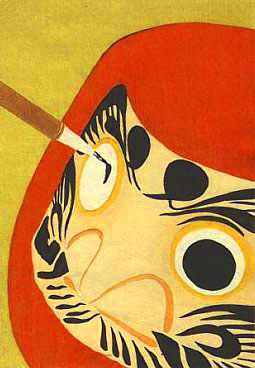
“Nanakorobi Yaoki” is translated to mean “seven times down, eight times up” — another way to say “never give up hope”.
The Daruma is a traditional Japanese doll modeled after Bodhi Dharma, the founder of the Zen sect of Buddhism. Daruma has a design that is rich in symbolism and is regarded as a talisman of good luck to the Japanese. These ‘dolls’ are seen as a symbol of perseverance and good luck, making them a popular gift of encouragement. They are usually made of papier-mâché, have a round shape, are hollow, and weighted at the bottom in a way that each doll will always return to an upright position when tipped over. This characteristic has come to symbolize the ability to have success, overcome adversity, and recover from misfortune. Due to this, Daruma is often illustrated alongside the phrase “Nanakorobi Yaoki”, translated to mean “seven times down, eight times up”, another way to say “never give up hope”. The eyes of Daruma are often blank when sold. The recipient of the doll fills in one eye upon setting the goal, then the other upon fulfilling it. In this way, every time they see the one-eyed Daruma, they recall the goal.
Knowing what we do about Ranald and his seemingly boundless desire and energy to explore and participate in his world, I can easily imagine that he would have been delighted to have had a Daruma – with all of the projects he managed to document, it’s likely he would have used up several of them in his lifetime. If there is anyone we can think of that epitomized the notion of “try, try again” it definitely was our friend Ranald MacDonald.
Posted in FOM Japan, Gates Ajar, Home | Comments Off on “Nanakorobi Yaoki” ~~ “七転八起” ダルマ精神
August 24th, 2012
Middle Village and Station Camp open house ceremony attracts crowd
By REBECCA SEDLAK
Reprinted with permission from The Daily Astorian of Astoria, Oregon
McGOWAN, Wash. — Middle Village and Station Camp Park held its grand opening Saturday after more than a decade of planning and collaboration.
The park is part of the National Park Service’s Washington expansion of the Lewis and Clark National Historical Park. Located between the north end of the Astoria Bridge and Chinook, Wash., along U.S. Highway 101, the park has been in the works since 2002, during the preparation of the Lewis and Clark Expedition’s Bicentennial.
“For some of us, it’s a miracle that it’s happening,” said Jim Sayce, the Middle Village and Station Camp project liaison with the Washington State Historical Society. “To build a park in the middle of a recession is just amazing. It just tells you that there are things worth doing. This is for the future. This has incredible worth across cultural lines.”
The project is the result of a partnership between the Chinook Indian Nation, the Washington State Historical Society, the McGowan–Garvin family, the National Park Service, the Washington State Parks and Recreation Commission and the Washington State Department of Transportation.
“We all had to stick together and get to know each other really well to get here. It’s so satisfying when you cross the line hand-in-hand with a bunch of other people,” David Szymanski, superintendent of Lewis and Clark National Historical Park, said of the partnership.
The park and its dedication
Saturday’s dedication began with a traditional Chinookan blessing given by Sam Robinson, vice chairman of the Chinook Nation. Numerous dignitaries and project partners gave short speeches in honor of the opening.
The 280-acre park features several lookout points to view the Columbia River, 2,400 feet of walking paths, three concrete canoe sculptures for children to play in, an unfinished traditional Chinook Indian plank house and numerous exhibits. Plans include connecting the trails to Fort Columbia and installing traditional Chinookan artwork.
“To me the Middle Village/Station Camp project represents the best of two worlds,” said Jennifer Kilmer, director of the Washington State Historical Society. “Through interpretive panels and exhibit-like structures we have the educational aspects of a great museum. Through its sweeping views of the Columbia River, walking paths and recreated beaches, we have the elements of a beautiful recreational experience. The combined experience is truly special.”
The Washington State Historical Society awarded Ray Gardner, chairman of the Chinook Nation, its Peace and Friendship Award during the ceremony.
The dedication ended with the cutting of an elk-hide leather rope to declare the park officially open. Afterward, the Pacific County Friends of Lewis and Clark hosted a reception in the Chinook School gymnasium.
Other attendees of Saturday’s dedication included David Nicandri, past director of the Washington State Historical Society; Karen Snyder, chairwoman of the Pacific County Friends of Lewis and Clark; Carolyn Glenn, the co-chairwoman of the Pacific County Friends of Lewis and Clark; Brian Baird, the former U.S. representative who represented the 3rd District; state Rep. Dean Takko, who represents the 19th district; state Sen. Brian Hatfield, who represents the 19th district; Sid Snyder, the former state senator who represented the 19th District; Bob Andrew, mayor of the city of Long Beach; Dale Jacobson, former mayor of the city of Long Beach; Schuyler Hoss, a representative from Gov. Christine Gregoire’s office; David Hodges, a representative from U.S. Sen. Patty Murray’s office; Kimberly Pincheira, a representative from U.S. Sen. Maria Cantwell’s office; Chip Jenkins, the superintendent for North Cascades National Park who was at Fort Clatsop during the bicentennial; Christine Lehnertz, the pacific west regional director of the National Park Service; other National Park Service staff; other members of the Chinook Nation; members of the McGowan-Garvin family; and representatives from the Washington State Department of Transportation..
The history of the site
“This is a place that has many stories, many meanings, and is important to many people for many different reasons,” Gardner said.
The Chinook people occupied the site for thousands of years.
“Our people, the Chinook people, were here to meet every new person who came into the area,” Gardner said.
When Capt. Robert Gray successfully entered the Columbia River in 1792, he traded with the Chinook. In the next 13 years almost 90 ships from Europe and America crossed the Columbia River Bar to trade.
The Lewis and Clark Expedition spent 10 days at Middle Village in November 1805. The Chinook had moved to their winter village, so the site was unoccupied. The short visit is where the term “Station Camp” comes from: William Clark used it as a survey station to create a map of the mouth of the Columbia River, the most detailed and accurate map produced during the expedition. The Corps of Discovery voted on Nov. 24, 1805 to find a winter camp on the south side of the river – a vote that included the Lemhi Shoshone woman Sacajawea and the African-American York.
The site continued to play an important role in trade in the lower Columbia Region until 1820.
“I don’t think there’s any site more significant than this one,” Szymanski said. “It’s a place where the world changed over 30 years; it changed dramatically.
“Archaeology and history tell us that we had one of the most sophisticated pre-contact cultures in North America here along this river. That’s gone. And we want people to know it was here.”
In 1848 a Catholic Mission was built at the site and later abandoned.
Oregon pioneer Patrick J. McGowan purchased the mission grant and 320 acres of land in 1853. He established a cannery and a small community. In 1904, McGowan donated land for St. Mary’s Catholic Church, which was built on the station camp site and now lies within the park.
“This place forces you to think about the past,” Bill Garvin, a descendent of McGowan, said at the ceremony Saturday. “What happened here was both uplifting and catastrophic. It’s one of those rare intersections where cultures collided.”
Only two families have owned the Middle Village and Station Camp Park site: the Chinook people and the McGowan-Garvin family.
“There have been visitors,” Gardner said. “There are people that have come and been here for a few days, and they’ve moved on. But the constant has always been those two families.
“I think all of us, no matter who we descended from, we all need to work to honor our ancestors because without them none of us would be here,” Gardner said. “I think we’ve got a place that’s a good beginning. There are more stories to be told here and they will as time goes on.”
Posted in Gates Ajar, Home | Comments Off on New park: ‘It’s a miracle that it’s happening’
May 31st, 2012
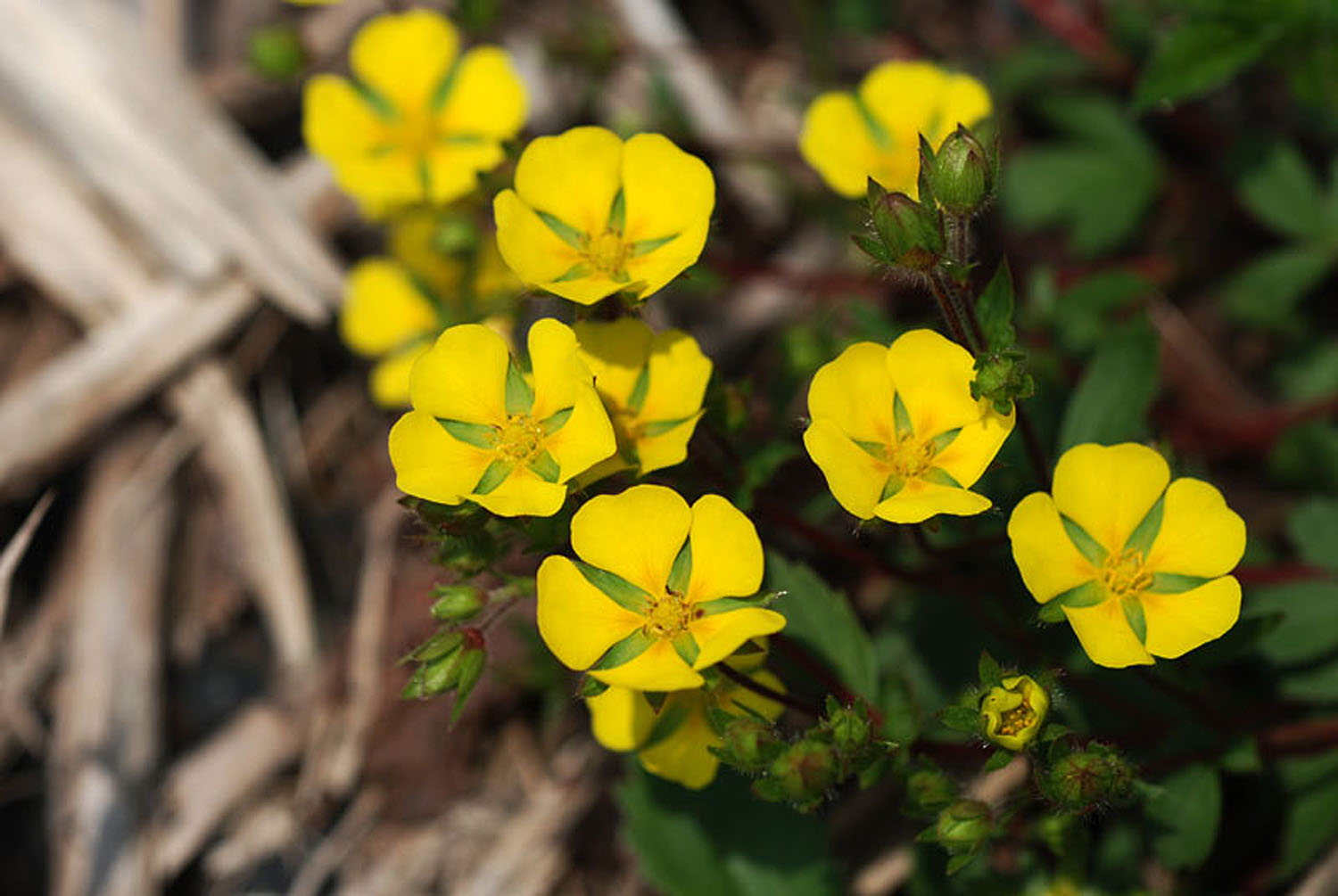 photos by Eiji Nishiya photos by Eiji Nishiya
‘ kijimushiro ‘
Potentilla fragarioides is a member of the Rosaceae family that is native to China, Japan, Korea, Mongolia, and Russia. The stem is boiled for use as a hemostatic in Traditional Chinese Medicine (TCM). D-Catechin has been isolated as the agent of action, being used to stem bleeding after childbirth.
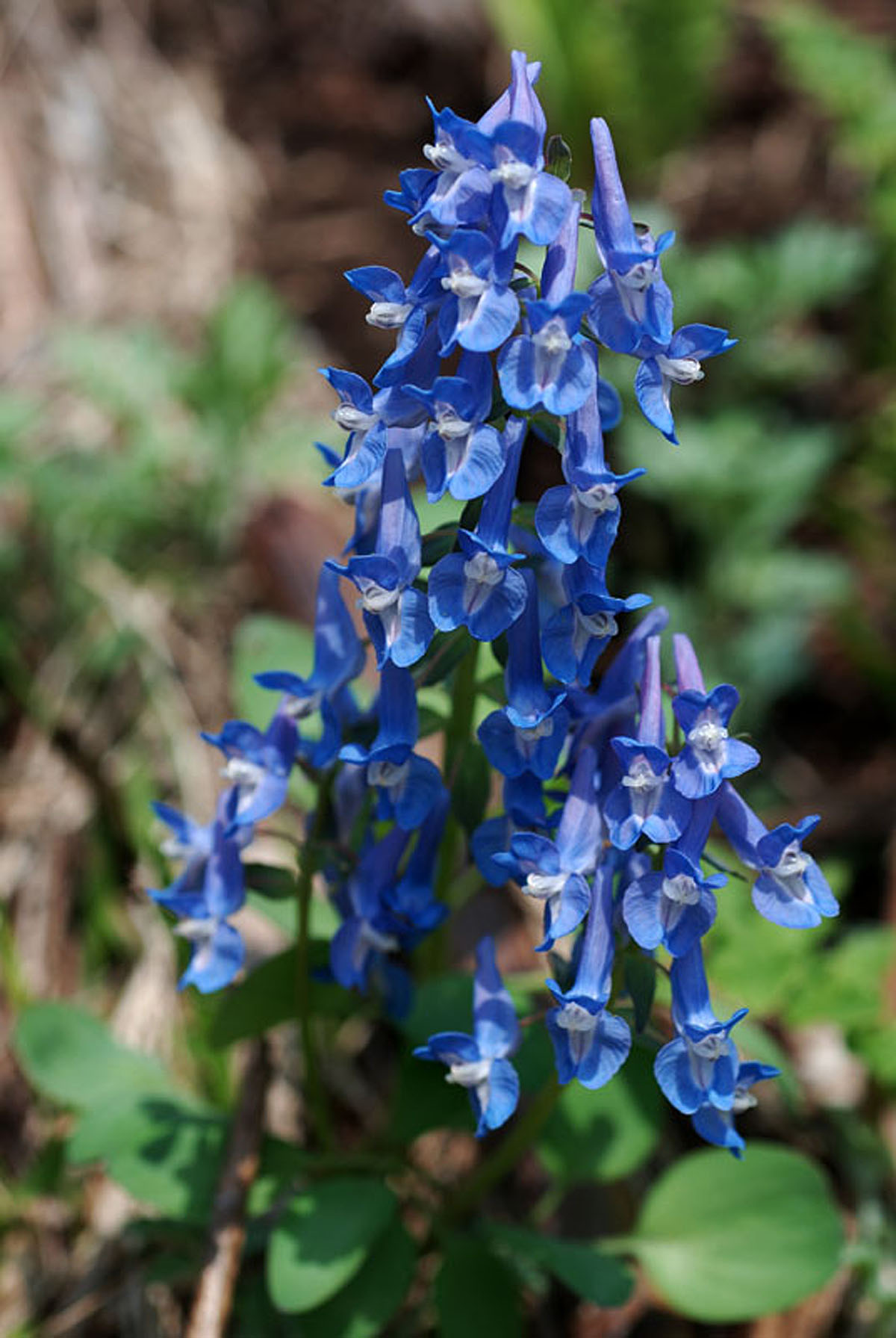
‘ ezo-engosaku ‘
Corydalis ambigua This plant is a perennial herb from the poppy family that grows in the deciduous broad-leaved forest. It blooms from April to May before other taller plants and trees start to bud. An array of colored flowers cover the forest floor in blue, purple, maroon and white. The flowers can be seen from the Maruyama Path leading towards Sapporo city mountain-climbing area, Asahikawa City, Niseko Town, Rishiri Town and many other places in Hokkaido. Chemicals present in Corydalis ambigua have been studied as potential ways to increase pain tolerance and for treating drug addiction. It is one of the 50 traditional herbs used in Chinese medicine.
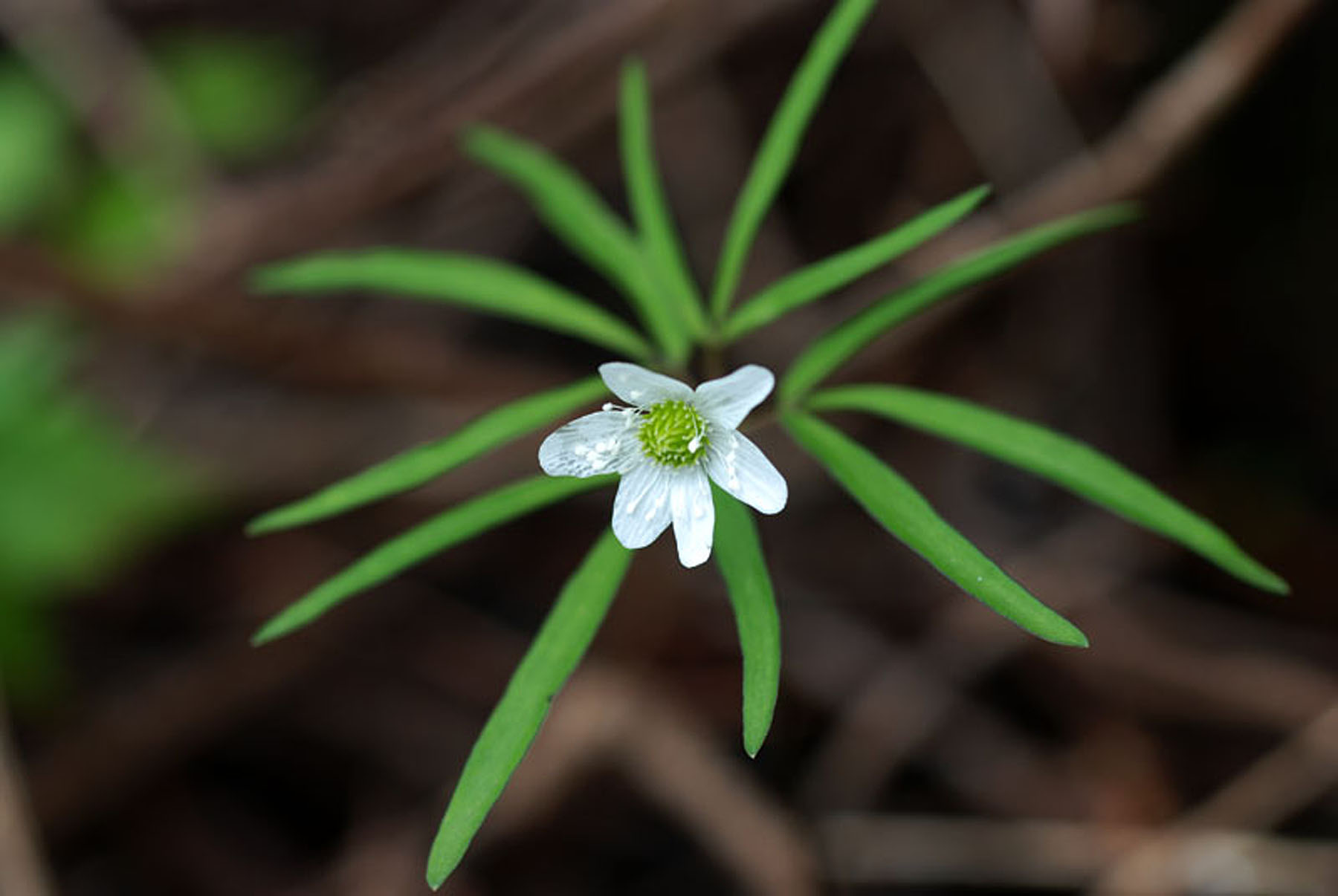
‘ hime-ichige ‘
Anemone debilis or Anemonoides debilis, sometimes called the European Thimbleweed, probably due to the shape of the seed cluster. These flowers can be really small:
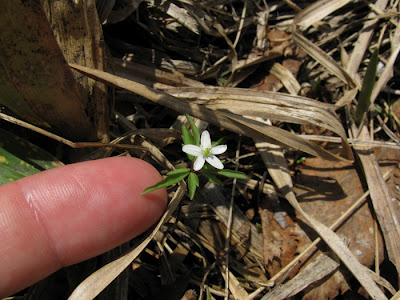 this is tiny! this is tiny!
Posted in FOM Japan, Gates Ajar, Home | Comments Off on Spring Wildflowers of Rishiri Island
April 10th, 2012
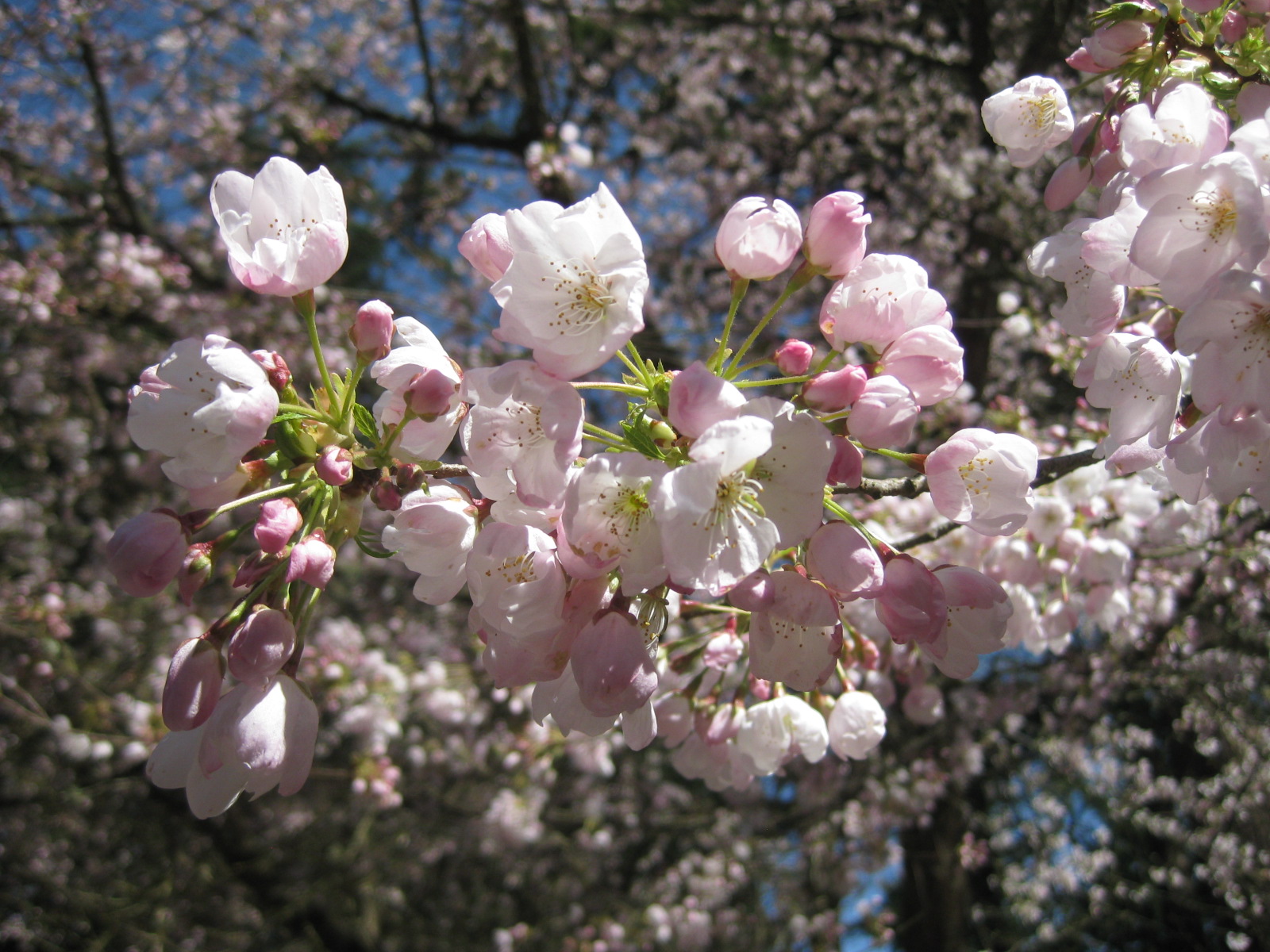
Photo by Mas Yatabe, taken at Portland Japanese Garden
Article By Ichiro Fujisaki, Ambassador of Japan to the United States ~ Reprinted from The Washington Post, January 21, 2012
This spring will mark the 100th anniversary of the chilly day in late March 1912 when two women in heavy coats dug into the earth along the north edge of the Tidal Basin to plant saplings. First lady Helen Taft and Viscountess Iwa Chinda, the wife of the Japanese ambassador to the United States, were joined by just a few people as they helped cherry blossom trees from half a world away take root in the nation’s capital.
When William Howard Taft became president in 1909, neither the Jefferson Memorial nor the Lincoln Memorial had been constructed. Mrs. Taft was hoping to host outdoor concerts and felt that the Tidal Basin area needed some embellishments.
Eliza Scidmore had long awaited such an opportunity. Scidmore, a travel writer, had fallen in love with the cherry blossom trees she saw gracing river banks in Tokyo while she visited her brother, a U.S. diplomat, when he lived in Japan. She had been trying for two decades to persuade authorities to plant them in the District.
David Fairchild of the Agriculture Department shared her view. Before the first lady’s project arose, he had imported some seedlings from Japan and given them to D.C. schools. Scidmore and Fairchild thought that the first lady’s project was a golden opportunity and recommended planting Japanese cherry trees. Mrs. Taft, who was familiar with cherry blossoms from visits to Japan, liked the idea and immediately requested the trees be planted. Col. Spencer Cosby was given the task.
At that time, renowned Japanese chemist Jokichi Takamine, who lived in New York, was visiting Washington. He was an advocate of improving U.S.- Japanese relations and was concerned by the hardening atmosphere in the United States toward Japan. Believing that the cherry blossoms could be a bridge between two peoples, Takamine had been working for years to persuade New York authorities to plant cherry trees along the Hudson River.
Takamine heard from his friend Scidmore about the first lady’s idea, and he proposed to donate 2,000 trees from Japan to the project. The Japanese consul general in New York, Kokichi Mizuno, who was also visiting Washington and was at the meeting with Takamine and Scidmore, proposed making the trees an official gift from the mayor of Tokyo, Japan’s capital city. Takamine, as a leader of the Japanese community in New York, agreed, and he went so far as to suggest to other Japanese in New York that, if official funding was not possible, contributions should be made by the leaders themselves.
The first lady welcomed the Japanese initiative. While Mizuno was communicating this situation to headquarters, the Japanese ambassador to the United States, Kogoro Takahira, confirmed the plan with the U.S. Secretary of State and also recommended to Japan’s foreign minister that the trees be an official gift from Tokyo. The Foreign Ministry then formally contacted the city of Tokyo. Mayor Yukio Ozaki, who was thankful for the role the United States had taken preparing negotiations leading to the Treaty of Portsmouth, which ended the Russo-Japanese War, seized this opportunity.
In 1909, he acquired the Tokyo City Council’s consent to donate 2,000 saplings. Transport across the Pacific was made available by Nippon Yusen Line, free of charge. Young trees about 10 feet tall arrived in Washington in January 1910. People were jubilant. The endeavor attracted media attention, including an article by Scidmore in Century magazine about the beauty of the trees. But just as it seemed everything had come together, U.S. Agriculture Department inspectors found that many of the trees were riddled with insects. The trees had to be burned. Ambassador Yasuya Uchida, who was then in Takahira’s post, wrote to Tokyo to defend the measures U.S. officials had taken and strongly recommended another attempt. The city of Tokyo decided, in April 1910, to donate as many as 3,000 specially grown germless saplings. This time the city took charge of the shipping as well. When the four-foot-tall saplings arrived in the District in March 1912, a thorough inspection was conducted. The trees were found to be in excellent condition, free from insects and plant diseases. It was decided that they should be planted at once. Only a few people, including Scidmore and Cosby, were present at the ceremony.
Ozaki visited Washington twice during the spring season. On both occasions, he composed traditional Japanese verses describing his strong attachment to those cherry trees Tokyo had given. His second visit came just five years after World War II, but he was honored in Congress for the gift. One of his poems reads:
“Viewing the cherry blossoms by the Potomac
Enchanted by the moon and appreciating the snow
There I will find the end of my life.”
Today, more than 3,000 trees surround the Tidal Basin, and approximately 100 of them are originals from 1912. When the Cherry Blossom Festival started in 1927, Mrs. Taft was the main guest, along with former first lady Edith Wilson. Just as the Statue of Liberty, a gift from France, has become a symbol of New York, cherry blossoms from Japan have become a symbol of Washington. The trees and their story are a living testament to the friendship between our peoples.
Commemorative Cherry Tree Planting at the Portland Japanese Garden ~
Thursday, April 12 ~ 10 a.m.–noon
Free with admission
In conjunction with the Japan-U.S. Cherry Blossom Festival Centennial and in collaboration with the the Consulate-General of Japan in Portland, the Japanese Garden will present a commemorative cherry tree planting in front of the Heavenly Falls on April 12th, 2012.
Posted in FOM Japan, Gates Ajar, Home | Comments Off on Cherry Blossoms and Friendship
February 4th, 2012
RISHIRI: A Pilgrimage … I want to say right now that I love Rishiri Island. A few FOM members have already written about their visits to various ‘Ranald-related places’ in Japan, and I was thrilled that, late in 2011, I got to go, too. This was a trip nearly two years in the making in part because of the sheer number of people and places we wanted to see while in Japan, but thankfully everything came together more or less as planned, and in late October we arrived at Wakkanai on the north-western tip of Hokkaido where we were met by our friend and long-time FOM member, Yamazaki-san, who, though he lives in Ebetsu, a suburb of Sapporo and a good 6-hour drive from Wakkanai, insisted on driving up to join us on the first leg of our journey – a two-day stay on Rishiri Island. It was our intent to spend time exploring Rishiri Island before catching the ferry back to Wakkanai and returning to Sapporo via Yamazaki-san’s car. [More about this later…]
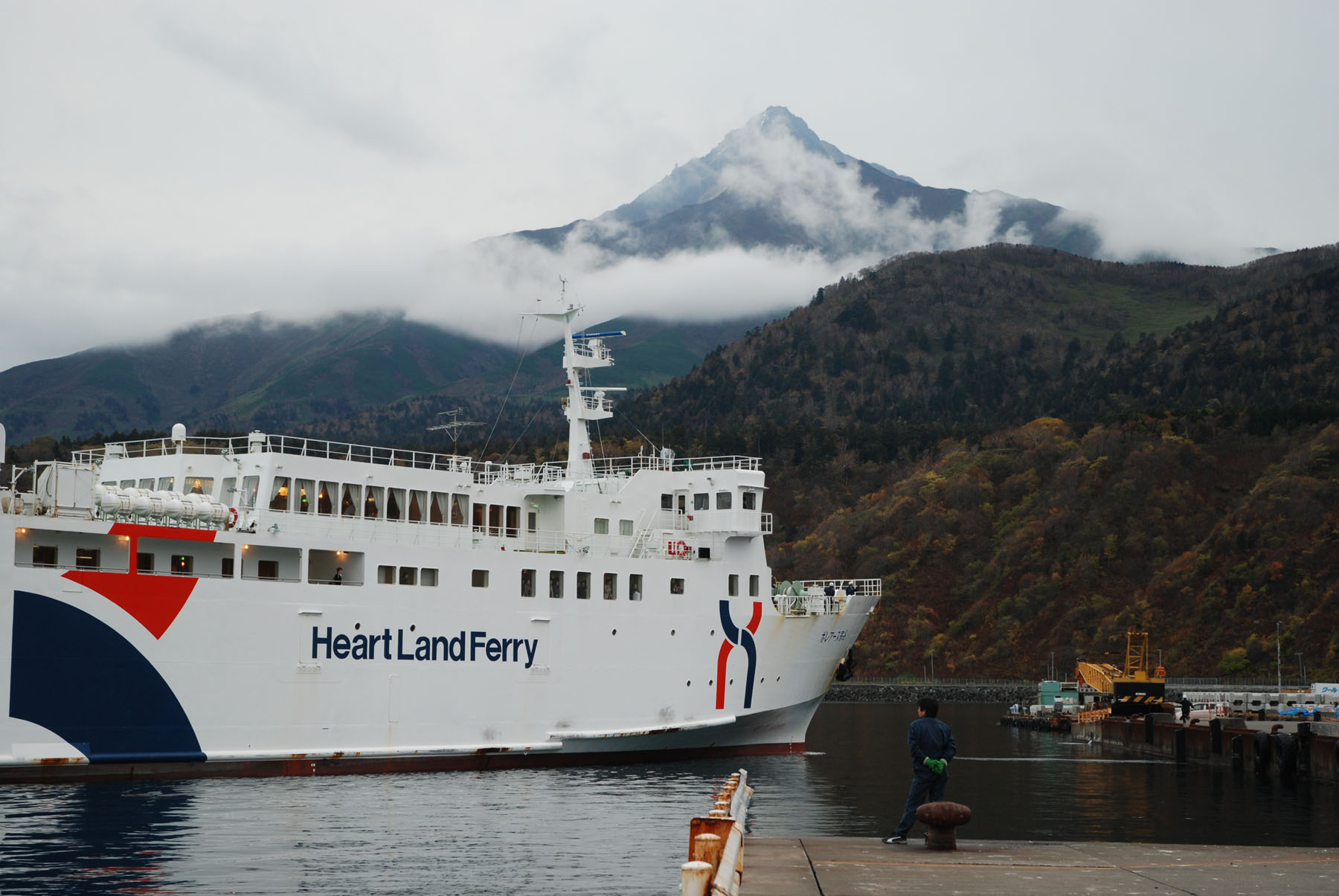
Our passage from Hokkaido to Rishiri was uneventful – just the way most people like their ocean travel to be. The Sea of Japan was calm as we stood out on the narrow, windy deck and watched the silhouette of Rishiri-Fuji grow larger and more detailed as we approached, commenting to each other that this was the same mountain peak Ranald set his sights upon as he struggled to maneuver his small, unwieldy boat closer to land on that long-ago July morning. There are, in fact, real similarities between the appearance of Rishiri-Fuji and Mt. Hood – the mountain of Ranald’s childhood – although whether this had any effect on Ranald [e.g., did he also see the resemblance between the two peaks?] only he himself could say. In my own humble opinion, by the time he got close enough to Rishiri Island to make out the details, I would venture that Ranald really didn’t care what Mt. Rishiri looked like – he simply wanted to find a place to safely “castaway”.
Mr. Eiji Nishiya, the dedicated and enthusiastic curator of the Rishiri Town Museum, met us when we docked – camera in hand, of course. [We know many good photographers, but I have to say that Mr. Nishiya takes his photography seriously, and I am always excited to open his newest emails to see what treasures he has sent us.] Mr. Nishiya took us on a brief drive along the ocean before delivering us to our initial destination – a modest western-style, “beachside” hotel that served breakfast and dinner and had its own in-house ‘onsen’. I’ve put the word “beachside” in quotation marks because, as far as I saw, there are no beaches on Rishiri Island, at least not the sandy kind; in fact, the shoreline reminded me very much of the Oregon Coast between the Sea Lion Caves and Seal Rock, where barely-eroded basalt flows meet the Pacific Ocean. Consequently, Rishiri felt very much like home to me [I grew up on the Oregon coast] and I spent much of the following days trying to convince Mr. Y. that it might be nice to immigrate to Rishiri sometime in the future. Even the storm that moved in overnight could not change my mind . . .
We were awakened the next morning by the sound of wind and rain against our window, but we are Oregonians and a little wind and rain is nothing to us. Mr. Nishiya was ready for us and by mid-morning we were happily rummaging through the Ranald MacDonald exhibit at the Rishiri Town Museum. All three of us were impressed by the number and quality of the exhibits, ranging from artifacts of the Ainu First Peoples to the subsequent influence of the Japanese who eventually displaced them, a creditable natural history exhibit of common and indigenous flora and [stuffed] fauna, a section devoted to the local industry of fishing and sea-farming and – of course – a well-placed and very well organized area devoted to none other than Ranald MacDonald. We could have easily and quite happily spent a few days examining Mr. Nishiya’s own private stash of MacDonald treasures, but arrangements had been made for Mr. Nishiya and Mr. Yatabe to give a brief presentation about Friends of MacDonald to the student body of one of the two island junior high schools – and we were all pleased and gratified that, once they had heard the incredible true story of Ranald MacDonald the First English Teacher in Japan, the kids were genuinely interested in and enthusiastic about “their” local hero.
Next we loaded into Mr. Nishiya’s car and drove around the whole, rocky island. Except for the difference in temperature [and the lack of palm trees!] I could have almost imagined myself on Maui, again because of the abundance of basalt and ancient lava flows. In fact, more than a few of the rocks had names – “Neguma no Iwa” [Sleeping Bear Rock] and “Jimmen Iwa” [The Rock Face] are just two examples. Mt. Rishiri is extinct – its last eruption is estimated to have been in 5830 BC – give or take 300 years – and erosion has produced an extremely rugged topography, but the wind and the waves have not yet been able to break all that basalt down into sand. This includes Notsuka Cove, where it is believed that Ranald first set foot on Rishiri; marginally protected from the elements, it is still used today by local fishermen. Like every other Pilgrim to that place, we stood and gazed out over the Sea of Japan and tried to imagine how it had been for him. And then, again like the others before me, I bent down to pick up a rock – to bring back to Toroda as an offering, perhaps? I found several, and even pocketed a couple, but something made me keep looking. I was soon rewarded by a flash of turquoise between the wet stones – a piece of glass float, broken and tumbled by the waves. Of course, Ranald never saw any glass floats while he was in Japan – Japan didn’t start using the glass floats until 1910.
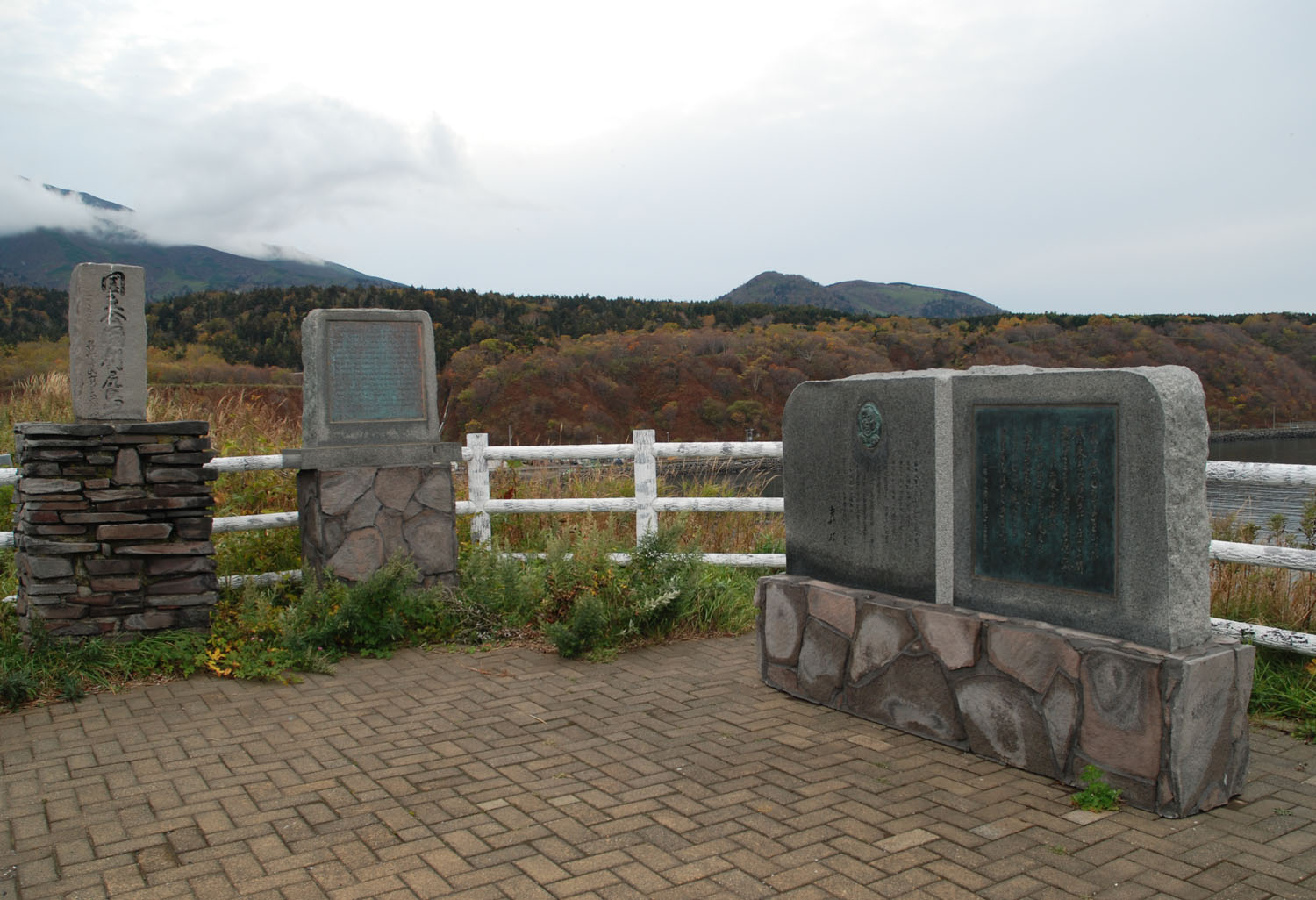
Before visiting Notsuka Cove we went to see the monuments memorializing Ranald’s exploits. The first has Ranald’s likeness and calligraphy of an excerpt from the novel “Umi no Sairei (海の祭礼)” (pub. 1986) by Akira Yoshimura (吉村 昭). The book became a sensation in Japan. There has been some confusion about the larger of the two monuments: in photos it looks as though there are two separate stones, but it is an illusion created by the way the granite is polished. This is, in fact, a single monument. The second monument on the left in the photo has the following inscription by Professor Emeritus of University of Hokkaido, Jyukichi Suzuki (鈴木重吉名誉教授) [Prof. Suzuki was born on Rishiri Island]:
“In 1848 ‘Kaei 1’ Ranald MacDonald born in Oregon reached ‘Notsuka’ pretending to be a shipwrecked sailar (sic). He felt deep racial connections with Japan across the Pacific although he knew of her total seclusion from the outside world. Inevitable he was arrested and sent to Nagasaki via Soya and Matsumae. During his imprisonment in Japan he did his best for mutual understanding and friendship between the two peoples transcending the language barrier. Five years later when Comm. Perry came to force open the closed doors of Japan, MacDonald’s former students at Nagasaki Einosuke Moriyama and others played an important role as interpreters. Thus Ranald enjoys the honor of being the first formal teacher of English and indirectly a father of modernizing Japan.”
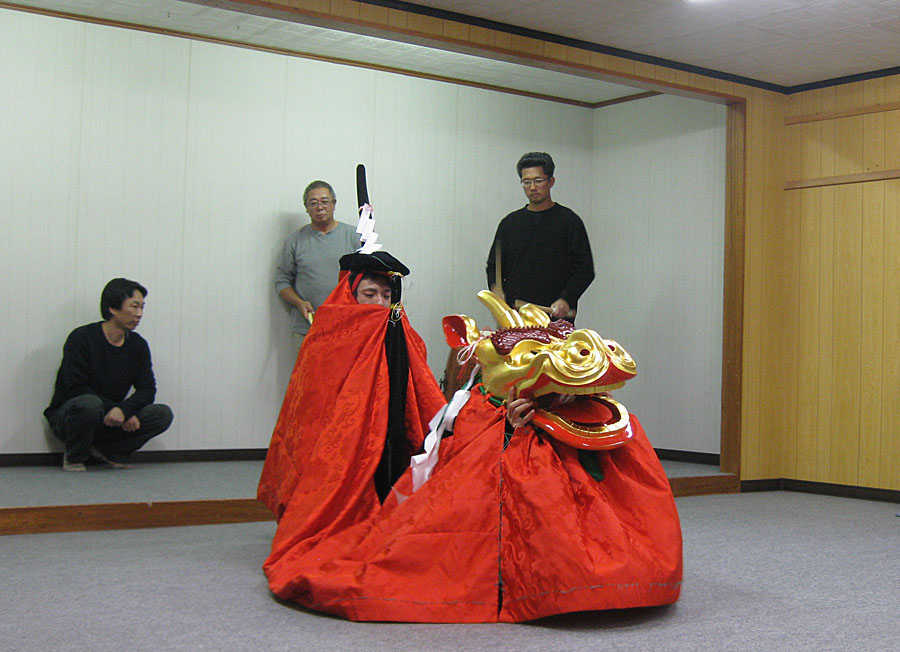 Later that evening we were treated to a very private practice session of a Kirin Shishi-Mai (麒麟獅子舞) conducted by some local residents, including Mr. Nishiya – who plays the Japanese bamboo flute. During a short break in the practice one of the men looked at us and grinned broadly. “No ferry tomorrow, too stormy!” he said with a laugh. “100% no ferry!” We all looked at each other in disbelief – would they actually cancel the only ferry back to Wakkanai? We had a plane to catch in Sapporo, and a tight itinerary to follow! Luckily we managed to get the last two seats in the very rear of the daily prop-jet flight from Rishiri Island to Sapporo [which, we later found out, is also frequently cancelled due to weather]. Sadly, we had to leave Mr. Yamazaki behind, promising that we would indeed drive down the western coast of Hokkaido with him on another day. . . Later that evening we were treated to a very private practice session of a Kirin Shishi-Mai (麒麟獅子舞) conducted by some local residents, including Mr. Nishiya – who plays the Japanese bamboo flute. During a short break in the practice one of the men looked at us and grinned broadly. “No ferry tomorrow, too stormy!” he said with a laugh. “100% no ferry!” We all looked at each other in disbelief – would they actually cancel the only ferry back to Wakkanai? We had a plane to catch in Sapporo, and a tight itinerary to follow! Luckily we managed to get the last two seats in the very rear of the daily prop-jet flight from Rishiri Island to Sapporo [which, we later found out, is also frequently cancelled due to weather]. Sadly, we had to leave Mr. Yamazaki behind, promising that we would indeed drive down the western coast of Hokkaido with him on another day. . .
Posted in Gates Ajar, Home | Comments Off on A pilgrimage …
|
 |
|



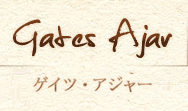
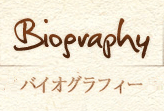



 名古屋市郊外在住の英語教師でマクドナルド友の会国際会員でもある今西佑子女史は、この度
名古屋市郊外在住の英語教師でマクドナルド友の会国際会員でもある今西佑子女史は、この度

 photos by Eiji Nishiya
photos by Eiji Nishiya

 this is tiny!
this is tiny!


 Later that evening we were treated to a very private practice session of a Kirin Shishi-Mai (麒麟獅子舞) conducted by some local residents, including Mr. Nishiya – who plays the Japanese bamboo flute. During a short break in the practice one of the men looked at us and grinned broadly. “No ferry tomorrow, too stormy!” he said with a laugh. “100% no ferry!” We all looked at each other in disbelief – would they actually cancel the only ferry back to Wakkanai? We had a plane to catch in Sapporo, and a tight itinerary to follow! Luckily we managed to get the last two seats in the very rear of the daily prop-jet flight from Rishiri Island to Sapporo [which, we later found out, is also frequently cancelled due to weather]. Sadly, we had to leave Mr. Yamazaki behind, promising that we would indeed drive down the western coast of Hokkaido with him on another day. . .
Later that evening we were treated to a very private practice session of a Kirin Shishi-Mai (麒麟獅子舞) conducted by some local residents, including Mr. Nishiya – who plays the Japanese bamboo flute. During a short break in the practice one of the men looked at us and grinned broadly. “No ferry tomorrow, too stormy!” he said with a laugh. “100% no ferry!” We all looked at each other in disbelief – would they actually cancel the only ferry back to Wakkanai? We had a plane to catch in Sapporo, and a tight itinerary to follow! Luckily we managed to get the last two seats in the very rear of the daily prop-jet flight from Rishiri Island to Sapporo [which, we later found out, is also frequently cancelled due to weather]. Sadly, we had to leave Mr. Yamazaki behind, promising that we would indeed drive down the western coast of Hokkaido with him on another day. . .